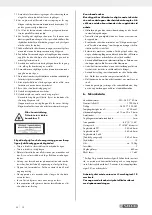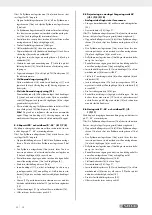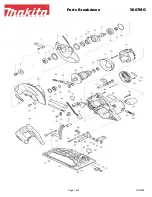
8
GB
The above-mentioned noise emission values can also be used
for the preliminary assessment of exposure.
Warning:
• The noise emissions during the actual use of the power tool
may differ from the above-mentioned values depending on
the power tool being used, in particular on the type of work-
piece being processed.
• Try to keep emissions as low as possible, for example by
limiting your working time. In this regard, all the operational
cycle phases must be taken into consideration (such as the
times when the tool is switched off or running idle).
7. Before starting the equipment
• Open the packaging and remove the device carefully.
• Remove the packaging material as well as the packaging
and transport bracing (if available).
• Check that the delivery is complete.
• Check the device and accessory parts for transport dam-
age.
• If possible, store the packaging until the warranty period
has expired.
ATTENTION
The device and packaging materials are not toys!
Children must not be allowed to play with plastic
bags, film and small parts! There is a risk of swal-
lowing and suffocation!
• The equipment must be set up where it can stand securely.
Secure the machine on a workbench or a base frame with 4
screws (not included in delivery) using the holes on the fixed
saw table (15).
• Pull out the pre-installed tilt protection (36) completely and
secure it with an Allen key (D).
• All covers and safety devices have to be properly fitted be-
fore the equipment is switched on.
• It must be possible for the blade to run freely.
• When working with wood that has been processed before,
watch out for foreign bodies such as nails or screws, etc.
• Before you press the ON/OFF switch check that the saw
blade is fitted correctly. Moving parts must run smoothly.
• Before you connect the equipment to the power supply make
sure the data on the rating plate are dentical to the mains
data.
7.1 Checking the moving saw blade guard safety
device (5)
The saw blade guard protects against accidental contact with
the saw blade and from chips flying around.
Check function
To do so, fold the saw downwards:
• The saw blade guard must provide free access to the saw
blade without touching other parts.
• When folding the saw upwards into the starting position,
the saw blade guard must cover the saw blade automati-
cally.
8. Attachment and operation
8.1 Attaching the crosscut, drag and mitre saw
(fig.1/2/4/5)
• In order to adjust the rotary table (14), loosen the handle
(11) approximately 2 turns and pull up the latched position
lever (35) with your index finger.
• Turn the rotary table (14) and pointer (12) to the desired
angle measurement on the scale (13) and use the handle
(11) to secure it.
• Pressing the machine head (4) lightly downwards and re-
moving the locking bolt (23) from the motor bracket at the
same time disengages the saw from the lowest position.
• Swing the machine head (4) up.
• It is possible to secure the clamping devices (7) to the left or
right on the fixed saw table (15). Insert the clamping devices
(7) in the holes on the rear side of the stop rail (16) and
secure it with the star grip screws (7a).
For 0°- 45° mitre cuts, the clamping device (7) must only be
mounted on the right side (see fig. 11-12).
• It is possible to tilt the machine head (4) a max. 45° to the
left by loosening the set screw (22).
• Workpiece supports (8) must always be secured and used
during work. Set the desired table size by loosening the set
screw (9). Then tighten the set screw (9) again.
8.2 Precision adjustment of the stop for crosscut
90° (fig. 1/2/5/6)
• No stop angle included.
• Lower the machine head (4) and secure it using the locking
bolt (23).
• Loosen the set screw (22).
• Position the angle stop (A) between the saw blade (6) and
the rotary table (14).
• Loosen the lock nut (26a).
• Adjust the adjusting screw (26) until the angle between the
saw blade (6) and rotary table (14) is 90°.
• Re-tighten the lock nut (26a).
• Subsequently check the position of the angle indicator. If
necessary loosen the pointer (19) using a Philips screwdriv-
er, set to position 0° on the angle scale (18) and re-tighten
the retaining screw.
8.3 Crosscut 90° and turntable 0° (fig. 1/2/7)
In the case of cutting widths up to approx. 100 mm it is possible
to fix the traction function of the saw with the set screw (20) in
the rear position. In this position the machine can be operated
in cross cutting mode. If the cutting width is over 100 mm then
it is necessary to ensure that the set screw (20) is loose and the
machine head (4) can move.
Attention! For 90° crosscuts, the moveable stop rail (16a) must
be fixed in the inner position.
• Open the set screw (16b) for the moveable stop rail (16a)
and push the moveable stop rail (16a) inwards.
• The moveable stop rail (16a) must be locked in a position far
enough from the inner position that the distance between the
stop rail (16a) and the saw blade (6) is no more than 8 mm..
• Before making the cut, check that the stop rail (16a) and the
saw blade (6) cannot collide.
• Re-tighten the set screw (16b).
Summary of Contents for 312188
Page 5: ...16 17 18 19 15 20 21 22 5 29 34 31 33 30 28 C 6 17 32 32a 32b E E E 32b ...
Page 73: ...68 DE AT CH ...
Page 75: ...70 ...
Page 77: ......
Page 78: ......
Page 79: ......














































